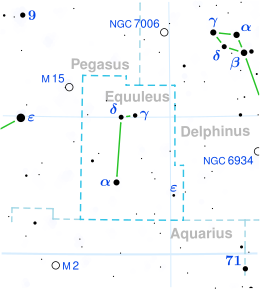Alpha Equulei
| Observation data Epoch J2000.0 Equinox J2000.0 | ||
|---|---|---|
| Constellation | Equuleus
| |
| Right ascension | 21h 15m 49.43192s[1] | |
| Declination | +05° 14′ 52.2430″[1] | |
| Apparent magnitude (V) | +3.919[2](4.49/4.96) | |
| Characteristics | ||
| Spectral type | G7III + kA3hA4mA9[3] | |
| U−B color index | +0.284[2] | |
| B−V color index | +0.529[2] | |
| Absolute magnitude (MV) | +0.17 (0.71 + 1.18)[3] | |
Semi-amplitude (K1)(primary) | 16.34 ± 0.07 km/s | |
| Semi-amplitude (K2) (secondary) | 17.9 ± 0.3 km/s | |
| Details | ||
| A | ||
Myr | ||
FK5 800, GC 29735 | ||
| Database references | ||
| SIMBAD | data | |
Alpha Equulei (α Equulei, abbreviated Alpha Equ, α Equ), officially named Kitalpha proper-motion star only 190 light-years away.
Nomenclature
α Equulei (Latinised to Alpha Equulei) is the star's Bayer designation.
It bore the traditional name Kitalpha (rarely Kitel Phard or Kitalphar), a contraction of the
Working Group on Star Names (WGSN)[7] to catalogue and standardize proper names for stars. The WGSN approved the name Kitalpha for this star on 21 August 2016 and it is now so entered in the IAU Catalog of Star Names.[6]
In
Properties
The overall appearance of α Equulei is a
spectroscopic binary
consisting of two individual stars.
The primary star is a G7 giant about fifty times more luminous than the Sun. It has an effective temperature of 5,100 K and a radius of 9.2 times greater than the Sun.
The secondary is an
A-type dwarf about 26 times as luminous as the sun. It has an effective temperature of 8,150 K and a radius 2.6 times greater than the sun. It is a chemically peculiar Am star.[3]
The two stars revolve in a circular orbit every 98.8 days. Their respective orbital velocities allow their masses to be calculated at 2.3 M☉ and 2.0 M☉, respectively.[3]
References
- ^ S2CID 18759600.Vizier catalog entry
- ^ Bibcode:1984SAAOC...8...59C.
- ^ .
- Bibcode:2000A&A...361..614P
- ISBN 978-1-931559-44-7.
- ^ a b "IAU Catalog of Star Names". Retrieved 28 July 2016.
- ^ IAU Working Group on Star Names (WGSN), International Astronomical Union, retrieved 22 May 2016.
- ISBN 978-986-7332-25-7.
- ^ (in Chinese) 香港太空館 - 研究資源 - 亮星中英對照表 Archived 2011-01-29 at the Wayback Machine, Hong Kong Space Museum. Accessed on line November 23, 2010.
- .

